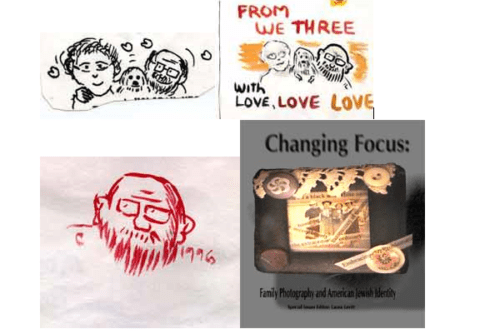Making Introductions: Opening Up the Space of Intimacy
These conversations begin with an acknowledgment of indebtedness to Marianne Hirsch. Marianne’s work on family photography 1 and the “familial gaze” 2 were instrumental in my efforts to imagine this special issue. As I explain, many of the contributors, Lorie Novak, Joanne Leonard, Ruth Ost, and I all met for the first time at “Family Pictures/Shapes of Memory,” the conference that Marianne organized at Dartmouth College in May of 1996. This acknowledgement is followed by Part One, “Revisionings: Seeing Jewish.”
All of the contributions to this section of the journal are by artists and critics who come to issues of Jewishness belatedly or obliquely. Here traces of Jewishness, which were often present but not central or defining in these contributors’ works, become more salient. Marianne Hirsch and Lorie Novak ask us to look again for how and in what ways Jewishness figures in Lorie’s work and on her website “Collected Visions.” Joanne Leonard and Michelle Citron use Jewishness as a lens through which to review some of the long-term preoccupations in their respective works. Joanne revisits “Reel Family,” her illuminated scroll in order to highlight how and in what ways Jewishness has always already figured in this and her other autobiographical collages and photographic works. Michelle Citron creates a website to look closer at some of the literal family images that animate her most recent film and writing projects. 3 Muriel Hasbun works from a much more complicated Jewish past. Her piece pays tribute to the Catholic Church and the specific church that kept her Jewish mother alive during the Second World War, both preserving and overtaking Muriel Hasbun’s own haunting Jewish past.
“Defamiliarizing the Jewish Familiar,” Part Two, includes works by and about women for whom Jewishness has been an ongoing preoccupation. All of these contributions challenge, in different ways, some of the assumptions that each has held dear about her own American Jewish identity. In these essays gender (Ost on Aylon), class (Booth), and generation (Levitt) complicate once familiar ways of being Jewish in America. At the heart of all of these essays are certain preoccupations that are repeated and returned to over and over again from different angles. This is evident in my essay as well as Ruth Ost’s contribution. In these ways each of these contributions frame and reframe what it means for one to see herself as a Jew in contemporary America.
One way or another, each of the contributions to this special issue argues that there is nothing intrinsically Jewish about any family image. Instead what makes a work, a text, a photograph or collage Jewish are the frameworks, the literal frames or screens or templates that make them visible. 4 It is the narratives and perspectives we bring to specific images that make them Jewish.
What follows are a series of meditations, explorations and engagements with visualizing Jewishness in America at the beginning of the twenty first century. Many of these contributions are experiments, ventures into new territory. They are very much works in process as opposed to finished pieces. It is my hope as guest editor that these artists and writers will continue their engagement with these issues, helping readers and viewers imagine a larger vision of what Jewishness can look like in the future. 5
- Marianne Hirsch, Family Frames: Photography, Narrative, and Postmemory, (Cambridge: Harvard University Press, 1997).[↑]
- Marianne Hirsch, ed. The Familial Gaze, (Hanover: University Press of New England, 1999).[↑]
- It was Michelle Citron’s powerful book Home Movies and Other Necessary Fictions (Minneapolis: University of Minnesota Press, 1999) that inspired me to invite her to Temple University as a guest of the Jewish Studies program. I called her out of the blue saying that although she is best known as a feminist filmmaker, I wanted to have her come and talk some about how Jewishness figured in her work. It was the way Jewishness figured in her book and her accounts of her family that brought her into these conversations. When I asked her to contribute to this issue she took the opportunity to create, “Jewish Looks,” a website specifically about some of her own family photographs.[↑]
- This is why I felt it worth asking first Lorie Novak and Joanne Leonard then Michelle Citron and Muriel Hasbun to reconsider their works as Jewish. I wanted to see what might happen if these works are viewed, seen, or read as Jewish. What does this lens make visible and what does it obscure?[↑]
- There are other works not included in this issue that also in different and provocative ways, raise additional questions about Jewishness and family photographs. I am especially moved by “Angels and Ghosts” by Raphael Goldchain, a remarkable Canadian artist. For a powerful analysis of this work, see Shelley Hornstein, “Archiving an Architecture of the Heart,” in Sighting the Holocaust: Contemporary Visions, edited by Shelley Hornstein, Laura Levitt and Laurence Silberstein, (New York: NYU Press, forthcoming). See also Raphael Goldchain’s website, http://zonezero.com/exposiciones/fotografos/goldchain/index.html.
In addition to this important work, I also want to call attention to another very different Canadian project, Karen Shopsowitz’ documentary film “My Father’s Camera.” For more information on this film see: http://www.nfb.ca/fatherscamera/index.html. Here again I am indebted to Shelley Hornstein for putting me in contact with Karen Shopsowitz. Although the primary focus of this issue has been on American Jews defined in terms of the United States, I want to acknowledge that these Canadian works alongside Muriel Hasbun’s contribution to this issue all suggest a broader vision of the various enactments of Jewishness that have been performed in all of the Americas.[↑]



